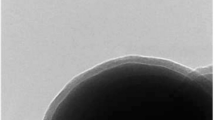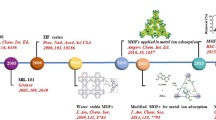Abstract
The use of titania (TiO2) nanoparticles as adsorbents for the adsorption of organic pollutants has attracted the attention of researchers over the years due to their stability, innocuousness, and economic cost. However, their adsorption performance has been limited, and various strategies are being explored to improve this. Herein, we demonstrated the induction of oxygen deficiency and modulation of the boundary layer of TiO2 through high-temperature treatment as a strategy for enhancing its adsorption performance. The high-temperature-treated samples denoted that HT-TiO2 was prepared by subjecting commercial Degussa P25 TiO2 to calcination at 700 ℃ for 2 h. Pristine samples designated Pr-TiO2 was utilized for comparison. The morphology, crystallinity, bulk elemental composition, and surface area of the samples were investigated using scanning electron microscopy (SEM), X-ray diffraction spectroscopy (XRD), electron diffraction spectroscopy (EDS), and Brunauer–Emmett–Teller (BET), respectively. Except for the morphology and porosity (obtained from nitrogen adsorption–desorption isotherm), both samples displayed varying characteristics. Experimental results reveal better adsorption performance of metronidazole (MNZ) on HT-TiO2 (qmax = 25.6937 mg/g) compared to Pr-TiO2 (qmax = 17.9856 mg/g). This phenomenon is attributed to oxygen deficiency and a smaller boundary layer on HT-TiO2 deduced from the EDS and intra-particle diffusion model.











Similar content being viewed by others
Abbreviations
- MNZ:
-
Metronidazole
- TiO2/TNPs:
-
Titanium dioxide/nanoparticles
- Pr-TiO2 :
-
Pristine TiO2
- HT-TiO2 :
-
High-temperature treated TiO2
- EDS:
-
Electron diffraction spectroscopy
- BET:
-
Brunauer–Emmett–Teller
- SEM:
-
Scanning electron microscopy
- TEM:
-
Transmission electron microscopy
- XRD:
-
X-ray diffraction
- PFO:
-
Pseudo-first order
- PSO:
-
Pseudo-second order
- PZC:
-
Point of zero charge
- RMSE:
-
Root mean square error
- MAE:
-
Mean average error
References
Aarab N, Laabd M, Eljazouli H et al (2019) Experimental and DFT studies of the removal of pharmaceutical metronidazole from water using polypyrrole. Int J Ind Chem 10:269–279. https://doi.org/10.1007/s40090-019-0190-7
Aarab N, Hsini A, Essekri A et al (2020) Removal of an emerging pharmaceutical pollutant (metronidazole) using PPY-PANi copolymer: kinetics, equilibrium and DFT identification of adsorption mechanism. Groundw Sustain Dev 11:100416. https://doi.org/10.1016/j.gsd.2020.100416
Agarwal S, Sadegh H, Monajjemi M et al (2016) Efficient removal of toxic bromothymol blue and methylene blue from wastewater by polyvinyl alcohol. J Mol Liq 218:191–197. https://doi.org/10.1016/j.molliq.2016.02.060
Ahmed MB, Zhou JL, Ngo HH, Guo W (2015) Adsorptive removal of antibiotics from water and wastewater: progress and challenges. Sci Total Environ 532:112–126. https://doi.org/10.1016/j.scitotenv.2015.05.130
Akhtar J, Amin NAS, Shahzad K (2016) A review on removal of pharmaceuticals from water by adsorption. Desalin Water Treat 57:12842–12860. https://doi.org/10.1080/19443994.2015.1051121
Alamgir TK, Wang B et al (2020) Effective adsorption of metronidazole antibiotic from water with a stable Zr(IV)-MOFs: insights from DFT, kinetics and thermodynamics studies. J Environ Chem Eng 8:103642. https://doi.org/10.1016/j.jece.2019.103642
Bekkouche S, Bouhelassa M, Salah NH, Meghlaoui FZ (2004) Study of adsorption of phenol on titanium oxide (TiO2). Desalination 166(2004):355–362
Blaser MJ (2016) Antibiotic use and its consequences for the normal microbiome. Science 352(6285):544–545. https://doi.org/10.1126/science.aad9358
Cao Y, Dhahad HA, El SMA et al (2021) Green synthesis of bimetallic ZnO–CuO nanoparticles and their cytotoxicity properties. Sci Rep. https://doi.org/10.1038/s41598-021-02937-1
Carrales-Alvarado DH, Ocampo-Pérez R, Leyva-Ramos R, Rivera-Utrilla J (2014) Removal of the antibiotic metronidazole by adsorption on various carbon materials from aqueous phase. J Colloid Interface Sci 436:276–285. https://doi.org/10.1016/j.jcis.2014.08.023
Ding H, Bian G (2015) Adsorption of metronidazole in aqueous solution by Fe-modified sepiolite. Desalin Water Treat 55:1620–1628. https://doi.org/10.1080/19443994.2014.927332
Flores-Cano JV, Sánchez-Polo M, Messoud J et al (2016) Overall adsorption rate of metronidazole, dimetridazole and diatrizoate on activated carbons prepared from coffee residues and almond shells. J Environ Manag 169:116–125. https://doi.org/10.1016/j.jenvman.2015.12.001
Ghribi F, Sehailia M, Aoudjit L et al (2020) Solar-light promoted photodegradation of metronidazole over ZnO-ZnAl2O4 heterojunction derived from 2D-layered double hydroxide structure. J Photochem Photobiol A Chem 397:112510. https://doi.org/10.1016/j.jphotochem.2020.112510
Gu P, Zhu X, Wu H et al (2018) Influence of oxygen vacancy on the response properties of TiO2 ultraviolet detector. J Alloys Compd. https://doi.org/10.1016/j.jallcom.2018.11.283
Gupta SM, Tripathi M (2011) A review of TiO2 nanoparticles. Chinese Sci Bull 56:1639–1657. https://doi.org/10.1007/s11434-011-4476-1
Hagedorn CH, Alpers DH (1977) Distribution of intrinsic factor-vitamin B12 receptors in human intestine. Gastroenterology 73:1019–1022. https://doi.org/10.1016/s0016-5085(19)31851-7
Hena S, Gutierrez L, Croué JP (2020) Removal of metronidazole from aqueous media by C. vulgaris. J Hazard Mater 384:121400. https://doi.org/10.1016/j.jhazmat.2019.121400
Homem V, Santos L (2011) Degradation and removal methods of antibiotics from aqueous matrices—a review. J Environ Manag 92:2304–2347. https://doi.org/10.1016/j.jenvman.2011.05.023
Hua Z, Wan S, Sun L et al (2018) Role of non-ion surfactants in three-dimensional ordered porous biomass carbon foam derived from the liquefied eucalyptus sawdust for metronidazole adsorption. J Chem Technol Biotechnol 93:3044–3055. https://doi.org/10.1002/jctb.5663
Igenepo K, Abdul A, Timothy A et al (2021) Unravelling the effect of crystal dislocation density and microstrain of titanium dioxide nanoparticles on tetracycline removal performance. Chem Phys Lett 776:138725. https://doi.org/10.1016/j.cplett.2021.138725
Ighalo JO, Igwegbe CA, Adeniyi AG et al (2020) Mitigation of metronidazole (Flagyl) pollution in aqueous media by adsorption : a review. Environ Technol Rev 9(1):137–148. https://doi.org/10.1080/21622515.2020.1849409
Ismael M (2020) Enhanced photocatalytic hydrogen production and degradation of organic pollutants from Fe (III) doped TiO2 nanoparticles. J Environ Chem Eng 8:103676. https://doi.org/10.1016/j.jece.2020.103676
Jung C, Son A, Her N et al (2015) Removal of endocrine disrupting compounds, pharmaceuticals, and personal care products in water using carbon nanotubes: a review. J Ind Eng Chem 27:1–11. https://doi.org/10.1016/j.jiec.2014.12.035
Leal JH, Cantu Y, Gonzalez DF, Parsons JG (2017) Brookite and anatase nanomaterial polymorphs of TiO2 synthesized from TiCl3. Inorg Chem Commun 84:28–32. https://doi.org/10.1016/j.inoche.2017.07.014
Li Y, Wang W, Wang F et al (2019) Enhanced photocatalytic degradation of organic dyes via defect-rich TiO2 prepared by dielectric barrier discharge plasma. Nanomaterials 9:720. https://doi.org/10.3390/nano9050720
Li X, Song Y, Zhang C et al (2021) Inverse CO2/C2H2 separation in a pillared-layer framework featuring a chlorine-modified channel by quadrupole-moment sieving. Sep Purif Technol 279:119608. https://doi.org/10.1016/j.seppur.2021.119608
Liu M, Hou LA, Yu S, Xi B, Zhao Y, Xia X (2013) MCM-41 impregnated with a zeolite precursor: synthesis, characterization and tetracycline antibiotics removal from aqueous solution. Chem Eng J 223:678–687. https://doi.org/10.1016/j.cej.2013.02.088
Manjunath SV, Kumar M (2018) Evaluation of single-component and multi-component adsorption of metronidazole, phosphate and nitrate on activated carbon from Prosopıs julıflora. Chem Eng J 346:525–534. https://doi.org/10.1016/j.cej.2018.04.013
Manjunath SV, Kumar SM, Ngo HH, Guo W (2017) Metronidazole removal in powder-activated carbon and concrete-containing graphene adsorption systems: estimation of kinetic, equilibrium and thermodynamic parameters and optimization of adsorption by a central composite design. J Environ Sci Heal—Part A Toxic/Hazard Subst Environ Eng 52:1269–1283. https://doi.org/10.1080/10934529.2017.1357406
Maorui H, Yifei W, Zhifeng Y et al (2021) Hierarchical dual-nanonet of polymer nanofibers and supramolecular nano fibrils for air filtration with a high filtration efficiency, low air resistance and high moisture permeation. J Mater Chem A 9:14093. https://doi.org/10.1039/d1ta01505b
Mu S, Liu Q, Kidkhunthod P et al (2020) Molecular grafting towards high-fraction active nanodots implanted in N-doped carbon for sodium dual-ion batteries. Natl Sci Rev 8:7. https://doi.org/10.1093/nsr/nwaa178/5896968
Nischk M, Mazierski P, Wei Z et al (2016) Enhanced photocatalytic, electrochemical and photoelectrochemical properties of TiO2 nanotubes arrays modified with Cu, AgCu and Bi nanoparticles obtained via radiolytic reduction. Appl Surf Sci 387:89–102. https://doi.org/10.1016/j.apsusc.2016.06.066
Omorogie MO, Babalola JO, Olatunde AM et al (2020) Microwave-synthesized and Fenton-functionalized Pinus sylvestris bark activated carbon/metal oxides for the effective uptake of tetracycline and congo red dye. Biomass Convers Biorefinery 10:959–975. https://doi.org/10.1007/s13399-019-00460-y
Prabu KM, Perumal S (2015) Micro strain and morphological studies of anatase and rutile phase TiO2 nanocrystals prepared via sol-gel and solvothermal method—a comparative study. Int J Sci Res Sci Eng Technol 1(4):299–304
Segovia-Sandoval SJ, Pastrana-Martínez LM, Ocampo-Pérez R et al (2020) Synthesis and characterization of carbon xerogel/graphene hybrids as adsorbents for metronidazole pharmaceutical removal: Effect of operating parameters. Sep Purif Technol 237:116341. https://doi.org/10.1016/j.seppur.2019.116341
Seo PW, Khan NA, Jhung SH (2017) Removal of nitroimidazole antibiotics from water by adsorption over metal–organic frameworks modified with urea or melamine. Chem Eng J 315:92–100. https://doi.org/10.1016/j.cej.2017.01.021
Sepehr MN, Al-Musawi TJ, Ghahramani E et al (2017) Adsorption performance of magnesium/aluminum layered double hydroxide nanoparticles for metronidazole from aqueous solution. Arab J Chem 10:611–623. https://doi.org/10.1016/j.arabjc.2016.07.003
Sun L, Chen D, Wan S, Yu Z (2018) Adsorption studies of dimetridazole and metronidazole onto biochar derived from sugarcane bagasse: kinetic, equilibrium, and mechanisms. J Polym Environ 26:765–777. https://doi.org/10.1007/s10924-017-0986-5
Velmurugan R, Krishnakumar B, Kumar R, Swaminathan M (2012) Solar active nano-TiO2 for mineralization of reactive Red 120 and Trypan blue. Arab J Chem 5:447–452. https://doi.org/10.1016/j.arabjc.2010.12.023
Wang W, Liu F, Wang B, Wang Y (2019) Effect of defects in TiO2 nanoplates with exposed 001 facets on the gas sensing properties. Chinese Chem Lett 30:1261–1265. https://doi.org/10.1016/j.cclet.2018.12.030
Yang JH, Bhargava P, McCloskey D et al (2017) Antibiotic-induced changes to the host metabolic environment inhibit drug efficacy and alter immune function. Cell Host Microbe 22:757-765.e3. https://doi.org/10.1016/j.chom.2017.10.020
Zeynep I, Aydın H, OğuzKaan Ö et al (2017) Highly efficient recovery of biophenols onto graphene oxide nanosheets: Valorisation of a biomass. J Mol Liq. https://doi.org/10.1016/j.molliq.2017.09.046
Zhang X, Tang Y, Zhang F, Lee C (2016) A novel aluminium—graphite dual-ion battery. Adv Energy Mater 6:1502588. https://doi.org/10.1002/aenm.201502588
Zhang B, He X, Ma X et al (2020) In situ synthesis of ultrafine TiO2 nanoparticles modified g-C3N4 heterojunction photocatalyst with enhanced photocatalytic activity. Sep Purif Technol. https://doi.org/10.1016/j.seppur.2020.116932
Zhang T, Wang Z, Xiang H et al (2021) Biocompatible superparamagnetic europium-doped iron oxide nanoparticle clusters as multifunctional nanoprobes for multimodal in vivo imaging. ACS Appl Mater Interfaces 13:33850–33861. https://doi.org/10.1021/acsami.1c07739
Acknowledgements
Laboratory of Department of Pure and Applied Chemistry, College of Natural and Applied Sciences, Veritas University Abuja, PMB 5171, Abuja, Nigeria.
Funding
No funding was received for this research.
Author information
Authors and Affiliations
Contributions
KIJ involved in conceptualization and writing—original draft; MO involved in investigation; HC, OJI, and AAA involved in methodology; VE and MOO involved in supervision of this research, review and editing; ATA involved in writing—review and editing.
Corresponding author
Ethics declarations
Conflict of interest
The authors declare that they have no known competing financial interests or personal relationships that could have influenced the work reported in this paper.
Consent to participate
All authors duly participated.
Consent for publication
All authors hereby consent to publish this manuscript.
Ethical approval
This article does not contain any studies involving human or animal subjects.
Additional information
Publisher's Note
Springer Nature remains neutral with regard to jurisdictional claims in published maps and institutional affiliations.
Rights and permissions
About this article
Cite this article
John, K.I., Obu, M., Adeleye, A.T. et al. Oxygen deficiency induction and boundary layer modulation for improved adsorption performance of titania nanoparticles. Chem. Pap. 76, 3829–3840 (2022). https://doi.org/10.1007/s11696-022-02126-y
Received:
Accepted:
Published:
Issue Date:
DOI: https://doi.org/10.1007/s11696-022-02126-y




